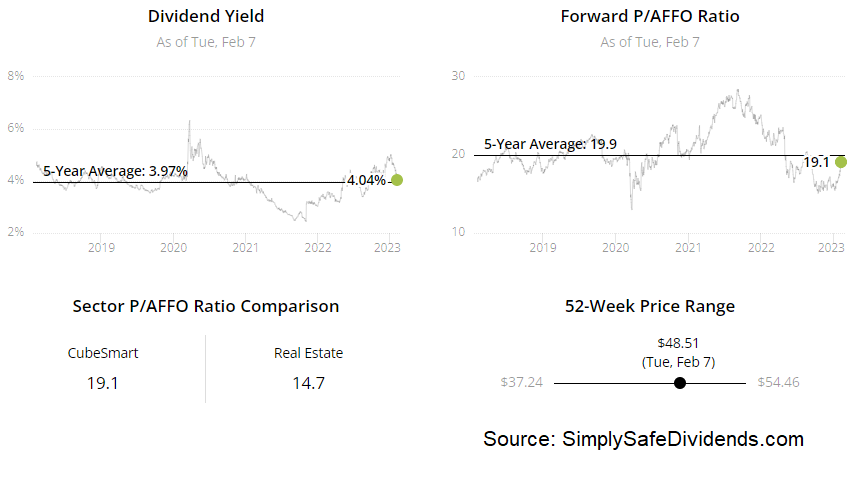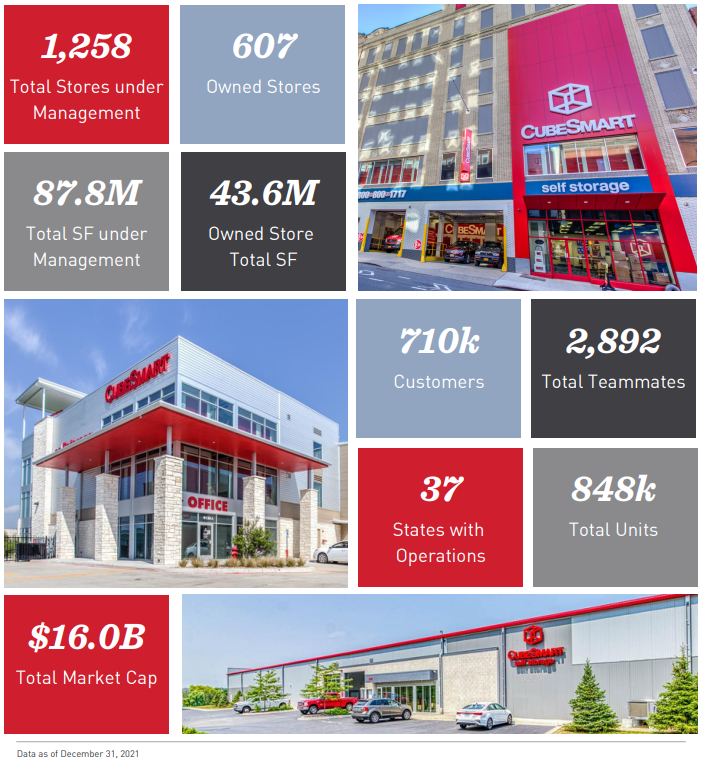We’re off to a fast start this year. As I write this, the S&P 500 is up more than 9% in 2023.
However, we had an epic collapse in 2022. So you have to keep perspective. And you always have to remember: Price is what you pay, but value is what you get.
Despite the runup in pricing, a lot of names remain deeply discounted relative to value. Finding those deals is something I take great pleasure in. And buying those deals is something I take even more pleasure in.
Well, I have been selectively buying high-quality dividend growth stocks. And there’s one name, in particular, that I think is worth your attention.
Today, I want to tell you about a dividend growth stock that I recently bought for the FIRE Fund.
Ready? Let’s dig in.
The dividend growth stock that I recently bought for the FIRE Fund is CubeSmart (CUBE).
CubeSmart is a self-storage real estate investment trust. This $10.5 billion (by market cap) self-administered and self-managed REIT is focused on the ownership, operation, acquisition, and development of self-storage facilities in the United States.
I love this business model.
 A self-storage REIT is a low-cost form of real estate because self-storage buildings are not complex to build, and they’re not expensive to maintain. Ongoing CapEx needs are minimal. You don’t need many employees to actually run a facility once it’s built, as the customers, once they’re onboarded, are doing most of the work – moving stuff in and out. Because of the low costs, you can generate high margins and benefit from fairly low breakeven rates when it comes to occupancy.
A self-storage REIT is a low-cost form of real estate because self-storage buildings are not complex to build, and they’re not expensive to maintain. Ongoing CapEx needs are minimal. You don’t need many employees to actually run a facility once it’s built, as the customers, once they’re onboarded, are doing most of the work – moving stuff in and out. Because of the low costs, you can generate high margins and benefit from fairly low breakeven rates when it comes to occupancy.
But occupancy isn’t a problem. Why? Because Americans like their stuff. Moreover, once stuff is in a storage facility, there’s a certain “stickiness” to that – inertia is a powerful force. And people tend to be loath to get rid of their possessions.
That’s why CubeSmart’s Q3 FY 2022 report showed that same-store occupancy during the quarter averaged 94.4%. And while CubeSmart is maintaining a high occupancy rate, they’re doing so with short leasing structures. This allows the company to adapt to changing economics very quickly, which is unlike most other REITs that feature long lease terms where they lock in rates.
 Let’s talk about the portfolio. CubeSmart owns over 1,200 properties across 39 US states. The REIT focuses on major markets, giving them pricing power and demographic advantages. And with over 700,000 customers, there’s plenty of customer diversification here.
Let’s talk about the portfolio. CubeSmart owns over 1,200 properties across 39 US states. The REIT focuses on major markets, giving them pricing power and demographic advantages. And with over 700,000 customers, there’s plenty of customer diversification here.
Total assets of $6.5 billion lines up against $3.7 billion in total liabilities. The REIT gets investment-grade credit ratings: BBB from Standard & Poor’s; Baa2, Moody’s.
What CubeSmart brings to the FIRE Fund is a great combination of growth and yield. CubeSmart has more than tripled its revenue over the last decade. Of course, they’ve been acquisitive. That hasn’t been all organic.
But even on a per-share basis, the numbers are fantastic. Adjusted funds from operations per share has compounded at an annual rate of 12.4% over the last decade. If we zoom in on the most recent quarter – Q3 FY 2022 – CubeSmart printed 23% YOY revenue growth. Adjusted funds from operations per share came in at $0.66 – a 17.9% increase YOY.
This kind of business growth is why we see phenomenal dividend growth.
 The REIT has increased its dividend for 13 consecutive years, with a 10-year DGR of 18.3%. Amazingly, the double-digit dividend growth persists – the most recent dividend raise, which was announced in December, came in at 14%. The new quarterly dividend is $0.49/share.
The REIT has increased its dividend for 13 consecutive years, with a 10-year DGR of 18.3%. Amazingly, the double-digit dividend growth persists – the most recent dividend raise, which was announced in December, came in at 14%. The new quarterly dividend is $0.49/share.
Meanwhile, CubeSmart is guiding for $2.51 at the midpoint in AFFO/share for FY 2022. That puts the payout ratio at 78.1%, which is a tad high, but not unreasonable, for a REIT.
Love the growth. But I really love the yield. Indeed, the stock is yielding 4%. That’s a pretty high yield in absolute terms, but it’s also high in relative terms. It’s significantly higher than the broader market’s yield. It’s also 20 basis points higher than the stock’s own five-year average yield.
So this is a stock that usually offers an above-average yield, but it’s especially high right now. This kind of yield isn’t super difficult to find in the market. What makes this dividend growth stock a bit unique is the growth you get with the yield. It’s that combination that is so appealing. And it’s this combination of growth and yield that has led to spectacular returns.
The stock has compounded at an annual rate of nearly 16% over the last decade. If you can compound your money at 16% annually, you’re going to become very wealthy over time.
 The S&P 500 is typically compounding at about 10% annually over the long run. And we can see that over the last 10 years, it did something pretty similar to that. But CubeSmart is running circles around the broader market – both in yield terms and total return. It’s the best of both worlds.
The S&P 500 is typically compounding at about 10% annually over the long run. And we can see that over the last 10 years, it did something pretty similar to that. But CubeSmart is running circles around the broader market – both in yield terms and total return. It’s the best of both worlds.
But wait. There’s more.
The stock is also attractively valued, in my view. It’s pretty rare that you get this kind of yield and growth wrapped up into one package. But when you do find such a package, it’s typically expensive. Not in this case. Using that aforementioned guidance, the forward price-to-adjusted-funds-from-operations ratio is 19.3.
That’s somewhat analogous to a P/E ratio on a normal stock. Is a 19.3 multiple unreasonable for a high-quality compounder yielding 4%? I really don’t think so. We can also see that the current P/CF ratio of 19.5 is a bit lower than its own five-year average of 19.7. I’d say that we’ve got a decent discount here. Not huge. But decent. And that’s why I bought the stock myself.
 I initiated a position in CubeSmart for the FIRE Fund in December at $43.20 per share. And I allocated more capital to this idea throughout December and January, with my most recent purchase occurring in January at $39.51 per share.
I initiated a position in CubeSmart for the FIRE Fund in December at $43.20 per share. And I allocated more capital to this idea throughout December and January, with my most recent purchase occurring in January at $39.51 per share.
Of course, I alerted my Patrons over at Patreon about these moves right after they were made. The stock was quite a bit cheaper when I was buying it, which made the valuation that much more attractive at the time.
The stock has had a huge run – up more than 20% on the year already. Is it now too expensive?
No, I don’t believe it’s too expensive. The numbers I’ve been giving are all current. As I shoot this video, the stock is priced at about $48.50. So that’s where I’m gauging things.
As I just said, the cash flow multiple is actually below its own five-year average. And the yield is above its own five-year average. In my view, this stock went from noticeably cheap to less cheap. Perhaps even something close to fair value. But I don’t think it’s necessarily expensive.
At 20 times AFFO, or something along those lines, I’d say that’s a fair deal. That would put the stock at $50. We’re getting close to that level now. If we get into the $55 range on the stock, that’s when I start thinking it’s expensive.
 Now, the business isn’t perfect. Every business has risks. Every business has drawbacks. No business is perfect. Litigation, regulation, and competition are omnipresent risks with every business.
Now, the business isn’t perfect. Every business has risks. Every business has drawbacks. No business is perfect. Litigation, regulation, and competition are omnipresent risks with every business.
Beyond that, some things to be aware of with CubeSmart, specifically, is the sensitivity to the housing market, interest rates, and the overall economy in the US. Those short leases can work against the firm, as customers can just leave. Also, it’s difficult to build durable competitive advantages here. The basic business model is very easy to replicate, making competition fierce.
So should you buy this stock? Well, that’s your call. Depends on your portfolio and what you’re looking to do with it. But I think CubeSmart offers a compelling total package.
You get a 4% yield, double-digit dividend growth, and market-beating performance. Yet this all comes at a valuation that is very acceptable. It’s at least worth having on your radar today, but a 10% correction back to the $44 area would make this a very interesting idea for long-term dividend growth investors.
— Jason Fieber
P.S. Would you like to see my entire stock portfolio — the portfolio that’s generating enough safe and growing passive dividend income to fund my financial freedom? Want to get an alert every time I make a new stock purchase or sale? Get EXCLUSIVE access here.
Source: Dividends & Income



